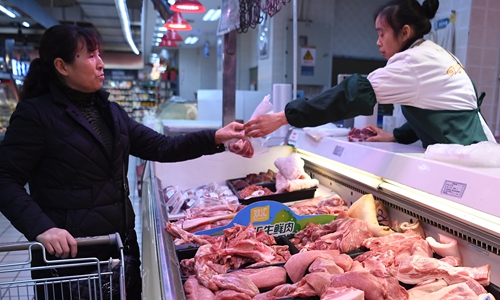Closures of US pork plants worsen shortages in China
By Chi Jingyi Source:Global Times Published: 2020/4/23 20:18:40

A resident buys pork in a supermarket in Southwest China's Chongqing Municipality. Photo: cnsphotos
US slaughtering plants are shutting down as a rising number of employees are infected with the coronavirus, a situation that has raised supply concerns as the US is the world's largest pork exporter.
China has been buying heavily from the US. Imports of US pork have skyrocketed this year. According to customs data, China imported 168,000 tons of pork from the US during the first quarter, up by 6.4 times and accounting for 17.7 percent of total imports.
Analysts said that domestic supply in China will continue to be affected by African swine fever and the COVID-19 epidemic.
US meat-processing company Tyson Foods announced on Wednesday the closure of its largest pork plant in Iowa, after nearly 200 workers tested positive for COVID-19. The closure followed others by the biggest pork processors in the US, including JBS, Hormel and Smithfield Foods.
"It is necessary to expand domestic production as imports are uncertain due to the pandemic," Ma Wenfeng, a senior analyst at Beijing Orient Agribusiness Consultancy, told the Global Times on Thursday. "It remains unknown how much pork the US will be able to export to China as production will definitely decline."
China's pork imports are expected to rise to 2.8 million tons in 2020, according to the agriculture outlook released on Tuesday by the Ministry of Agriculture and Rural Affairs. Pork consumption is expected to be 42.06 million tons in 2020, down 5.6 percent year-on-year, while domestic production is expected to be 39.34 million tons, with a supply gap of 2.72 million tons.
"The supply-demand gap is likely to expand 32.7 percent year-on-year. Pork prices will remain high due to the tight supply of live pigs until the end of 2021, when pork production capacity is expected to recover," Zhou Lin, an analyst at the agriculture ministry, said on Tuesday.
The gap in 2019 was filled by imports. Data from customs showed that China imported 2.1 million tons of pork, with a gap of 2.08 million tons.
"Supply will gradually improve after July. As there are more festivals in the second half of the year than in the first half, the price peak may arrive around September," Yang Zhenhai, head of the Department of Livestock Production at the agriculture industry, said on Tuesday.
The rising pork price is partly due to the surging cost of feed, said a Henan Province-based fodder producer.
"As a result of the coronavirus outbreak, our costs have increased, including transportation costs, labor costs, as well as disinfectants, masks and other procurement costs. Thus, the feed price will probably continue to go up until the end of the year, depending on the control of the epidemic," the company told the Global Times on Thursday.
Posted in: INDUSTRIES,BIZ FOCUS